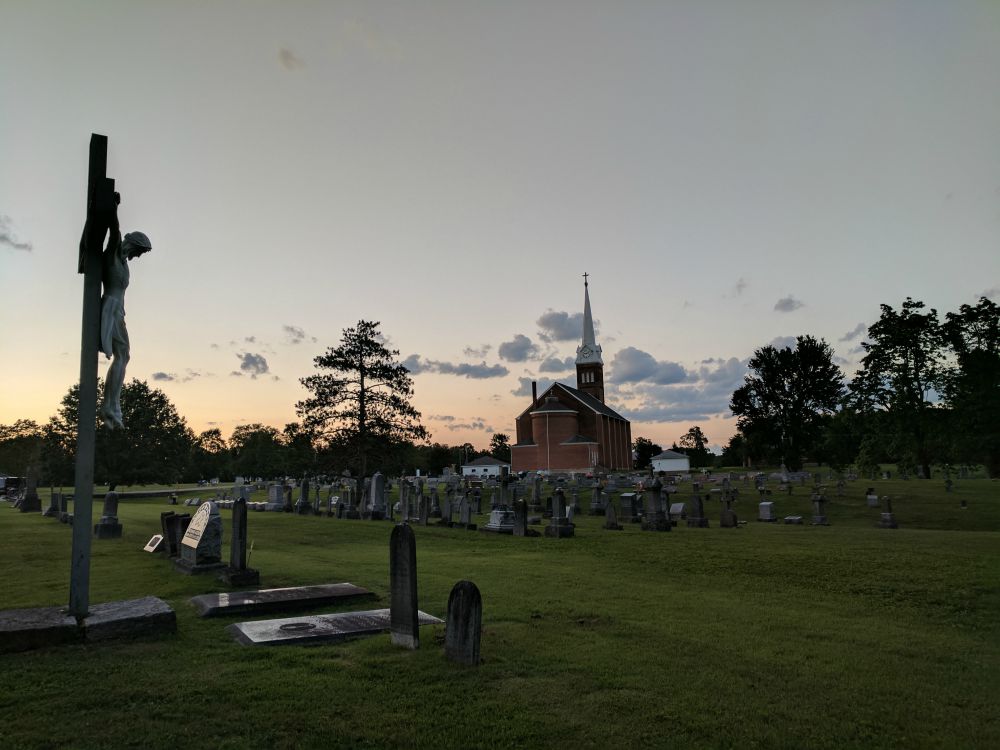
(Unsplash/Kenny Stier)
A newborn is lifted from its mother and placed on a warming bed to be weighed and measured. The baby lies on its back, arms out to the side, legs splayed apart, all the tender surfaces — from neck to groin — laid open, exposed. The baby does not know how to protect, how to guard, how to defend. Pictures of the newborn Jesus show him swaddled and wrapped in the protective arms of his mother, or swaddled and cradled in the manger. But when he was lifted, squalling, from his mother's womb, when Mary cleaned him and changed his gown and blankets, Jesus was, in the way of all babies, exposed and vulnerable. This is the way the Lord of the universe, the Savior, God, chose to come into the world.
Look at pictures of Jesus hanging on the cross and consider how similar is the posture of his dying to the posture of his birth: Arms out to the side, legs splayed apart, neck thrown back in supplication or agony, all the tender surfaces — from neck to groin — laid open, exposed.
And, in all of it, Jesus is undefended. Before he begins his public ministry, he rejects Satan's offers of power and protection. Before Jesus' arrest, when his followers realize what is about to happen, they ask, "Lord, shall we strike with a sword?"
One of them did not wait for Jesus' answer, but cut off the ear of the high priest's servant.
Jesus' replied, "Stop, no more of this!" Luke's Gospel continues, "Then he touched the servant's ear and healed him."
When the worshippers at the First Baptist Church in Sutherland Springs, Texas, were mowed down by a rifle-wielding gunman on Sunday, Nov. 5, the massacre provided more encouragement for those who believe churches should be open to guns, including armed security guards, armed staff and armed worshippers. They say that we live in a dangerous world.
For Christians, it is worth considering that Jesus was born into a dangerous world. Shortly after Jesus' birth, King Herod set out to find the baby and kill him. Not wanting to miss his target, Herod made the decision to murder every Jewish baby boy up to the age of two. Surely one of them would be the feared child. The child was spared only because Joseph, warned of the danger by an angel in a dream, took Mary and Jesus and escaped into Egypt. There were so many others in Israel, who, just like the murdered children of Sutherland Springs, were not spared.
Advertisement
But Joseph had no armed guards and carried no arms. When the time had come for Jesus to begin his public ministry, he went unarmed into the desert where Satan was waiting for him. Jesus went unarmed to Jerusalem where arrest was waiting for him. He went unarmed to the garden where his accusers would find him. He went unarmed before Pilate and before the jeering crowds. He went unarmed to the cross where death was waiting for him. And Jesus met death there with a forgiveness that made first-century people wonder at his weakness and impotence. How, many asked, can we worship a god who dies? What kind of foolishness is that?
This Jesus Christ who died on the cross and rose again is the One we worship, the One before whom we bow, the One we seek to serve, the One whose birth we celebrate at Christmas. And we Christians cannot have an honest conversation about guns in church without considering the manner in which Jesus was born as a man, lived as a man and died as a man.
We also can't have an honest conversation about guns in church without an understanding that to wake and rise and holster a weapon is to go forth into the world expecting to meet someone who needs to be shot. Having a gun not only increases the likelihood that one will shoot another, it is, in fact, the only way that will happen. A person without a gun cannot shoot a gun. Only a person with a gun can do so.
Should Christians go to church with that assumption? Or are we called to go into the world as Jesus went into the world? Are we called, not to the safety for which I long, for myself and my family, but to faithfulness? Are we to understand, without glorifying death, that we may be called to faithfulness unto death? That we may be asked not only to live like Jesus, but also to die like him?
As followers of Christ are we called to actually follow him?
I am not suggesting that we cannot better learn to identify and contain threats, threats that include fires and natural disasters as well as violence. I am suggesting that there are layers and layers of prevention possible before we ever need reach the level of deadly force. It is reasonable for a parish to have a security plan in place. It is reasonable for parishioners to have basic guidelines in place for emergencies. It is reasonable for ushers to receive the kind of training that people who run soup kitchens and homeless shelters routinely offer their own staff.
These steps are reasonable, but not essential. What is essential is that we come together to worship as the body of Christ, a body that, while on Earth, never took up arms against another. What is essential is that church remain the place we go, not to take up our weapons but to lay our weapons down, all of them. We lay our weapons down before the altar where we worship Christ, who faced death in all its fury and refused to answer death with more death.
[Melissa Musick Nussbaum's latest book, with co-author Anna Keating, is The Catholic Catalogue: A Field Guide to the Daily Acts That Make Up a Catholic Life.]
Editor's note: We can send you an email alert every time this column, My Table Is Spread, is posted. Go to this page and follow directions: Email alert signup.








